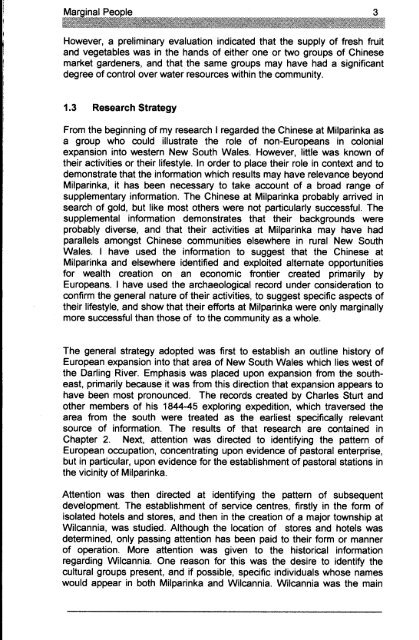Adec Preview Generated PDF File - The Sydney eScholarship ...
Adec Preview Generated PDF File - The Sydney eScholarship ...
Adec Preview Generated PDF File - The Sydney eScholarship ...
You also want an ePaper? Increase the reach of your titles
YUMPU automatically turns print PDFs into web optimized ePapers that Google loves.
However, a preliminary evaluation indicated that the supply of fresh fruit<br />
and vegetables was in the hands of either one or two groups of Chinese<br />
market gardeners, and that the same groups may have had a significant<br />
degree of control over water resources within the community.<br />
1.3 Research Strategy<br />
From the beginning of my research I regarded the Chinese at Milparinka as<br />
a group who could illustrate the role of non-Europeans in colonial<br />
expansion into western New South Wales. However, little was known of<br />
their activities or their lifestyle. In order to place their role in context and to<br />
demonstrate that the information which results may have relevance beyond<br />
Milparinka, it has been necessary to take account of a broad range of<br />
supplementary information. <strong>The</strong> Chinese at Milparinka probably arrived in<br />
search of gold, but like most others were not particularly successful. <strong>The</strong><br />
supplemental information demonstrates that their backgrounds were<br />
probably diverse, and that their activities at Milparinka may have had<br />
parallels amongst Chinese communities elsewhere in rural New South<br />
Wales. I have used the information to suggest that the Chinese at<br />
Milparinka and elsewhere identified and exploited alternate opportunities<br />
for wealth creation on an economic frontier created primarily by<br />
Europeans. I have used the archaeological record under consideration to<br />
confirm the general nature of their activities, to suggest specific aspects of<br />
their lifestyle, and show that their efforts at Milparinka were only marginally<br />
more successful than those of to the community as a whole.<br />
<strong>The</strong> general strategy adopted was first to establish an outline history of<br />
European expansion into that area of New South Wales which lies west of<br />
the Darling River. Emphasis was placed upon expansion from the southeast,<br />
primarily because it was from this direction that expansion appears to<br />
have been most pronounced. <strong>The</strong> records created by Charles Sturt and<br />
other members of his 1844-45 exploring expedition, which traversed the<br />
area from the south were treated as the earliest specifically relevant<br />
source of information. <strong>The</strong> results of that research are contained in<br />
Chapter 2. Next, attention was directed to identifying the pattern of<br />
European occupation, concentrating upon evidence of pastoral enterprise,<br />
but in particular, upon evidence for the establishment of pastoral stations in<br />
the vicinity of Milparinka.<br />
Attention was then directed at identifying the pattern of subsequent<br />
development. <strong>The</strong> establishment of service centres, firstly in the form of<br />
isolated hotels and stores, and then in the creation of a major township at<br />
Wilcannia, was studied. Although the location of stores and hotels was<br />
determined, only passing attention has been paid to their form or manner<br />
of operation. More attention was given to the historical information<br />
regarding Wilcannia. One reason for this was the desire to identify the<br />
cultural groups present, and if possible, specific individuals whose names<br />
would appear in both Milparinka and Wilcannia. Wilcannia was the main




